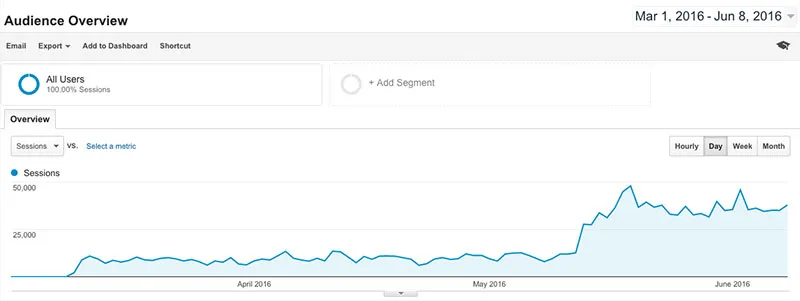How we went from zero to 1 million visits a month
After our last failed beauty marketplace startup, Stylish, we worked on a couple of experiments before finally starting our digital healthcare startup, Glowpink. We began working on Glowpink in March 2016 and achieved traffic of over one million visits per month within three months. Like most bootstrapped startups, we had zero budget for marketing, but knew that great content is something that has the potential to reach millions of people, without spending a single penny. Now we all know that content is king, but how to convert content into traffic is something that most of us struggle with. Here are some of our learnings on this subject.

Image : Shutterstock
1) Launch the blog prior to the product
We had launched our free Q&A in mid-April, but launched our blog much earlier: the first week of March. That way we could start marketing the content and the website much before the actual product launch. Blogging and creating original content has worked wonders for numerous startups, including the likes of Mint.com. In the words of Jason Putorti, fifth employee of Mint, “Quite simply, we focused on building out a unique personal finance blog, very content-rich, that spoke to a young professional crowd that we felt was being neglected. Eventually the blog became #1 in personal finance and drove traffic to the app. Our app didn't have a high viral coefficient but we had content that was. Our infographics and popular articles became regular hits on Digg, Reddit, etc.”
2) Shareable content
Previously, ‘link baits’ used to work really well with social media, but no longer, especially if you are going to depend a lot on Facebook, like we did. If you want your content to reach to a large audience, make sure that you generate lot of shareable content. Now you might ask, how would you develop shareable content, especially that strikes cords with your audience? Study your competitors, especially their blogs, fan pages, and Twitter handles, and analyse what kind of content is getting shared a lot. That will give you enough insight into what will work for your audience too.

Like many other health startups, the theme that worked really well with our audience was health and beauty tips and home remedies. So we made sure that most of our content revolved around these themes. And because we had set aggressive targets for ourselves, it was never enough to do some shareable content but a lot! Just among the founders, we were doing about 12 to 15 articles daily.
3) Ride on the trending topics
While creating ‘evergreen content’ is a great strategy, you definitely want to cash-in on traffic that comes with trending topics, especially because this is one of the easiest ways to get lots of traffic for free. To make sure that we don't miss out on such opportunities, we have made this a daily morning routine to check all social media sites, including Facebook and Twitter, to look for any trending topics that might be relevant for our audience.
4) Get data driven
To make sure that our efforts in creating content are going in the right direction, we identified a good number of buckets for categorising our content. For example, we discovered that content related to Bollywood celebrity motherhood drove tons of traffic to our site. We constantly keep measuring what kind of buckets are performing well and we try to do more of that content; but of course, too much of anything can yield negative results. We used a simple Excel sheet to track the performance of our various buckets, but there definitely should be a better way of doing this.

5) “SEO is dead” is a myth
No, SEO is not dead. Far from being dead, SEO has become increasingly important because searches have become an increasingly frequent activity of users, especially on mobile devices. Yes, traditional SEO that involves keyword stuffing, buying exact match domains or thin content websites, are long dead. But doing your keyword research, creating good content around the keywords that matter, and making your site’s content easily and quickly ‘crawlable’ is not dead. We can backup this claim because we already rank on the first page for Google searches for a few keywords and have been getting some good traffic from these.
Apparently Google got over 100 billion searches a month in 2015 and more than half of those searches came from mobile devices. This number is only growing, so now that should be reason enough for you to consider SEO as an important strategy to acquire users.
In conclusion, if you have little to no budget for marketing, then content marketing and SEO are probably the best strategies for user acquisition. If done right, they can yield substantial results, even in a short span of time. The tools that we use on a daily basis include Buffer, Moz, BuzzSumo, and Google Analytics.
(Disclaimer: The views and opinions expressed in this article are those of the author and do not necessarily reflect the views of YourStory.)







